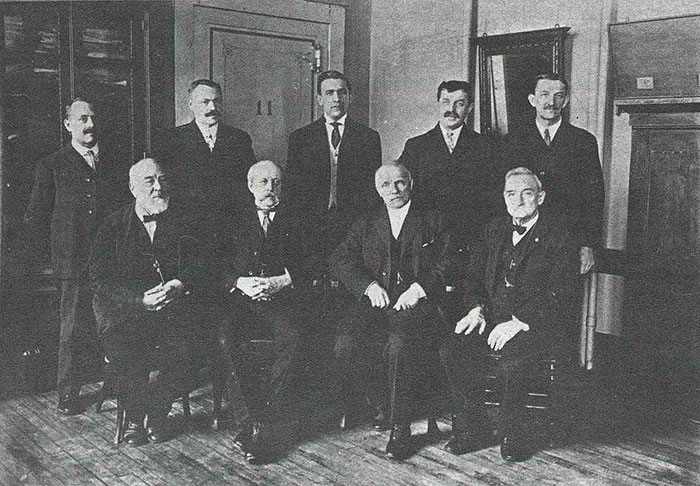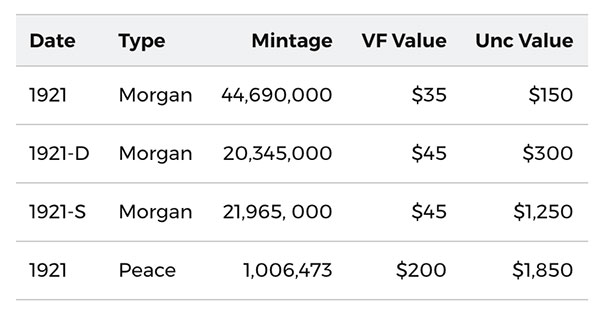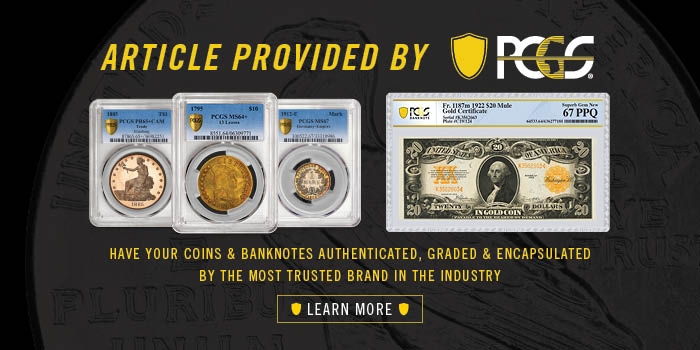Numismatic Change in 1921 by Mike Garofalo for PCGS ……
The year was 1921. America, much like today, was a dynamic and changing place. President Woodrow Wilson, who kept us out of “The War to End All Wars” from 1914 to 1916, had finally led us into and then through that Great War in 1917 and 1918, and the United States contributed both blood and treasure to winning that war.

The German threat to Europe was no more – at least for the next decade or so – and a new president was trying to usher in a period that would push America back from a war-time economy to a peace-time economy. Wilson committed to a peaceful transition of power as Warren G. Harding was sworn in as president on the traditional March 4 date.
Also like today, America in 1921 had dealt with a worldwide pandemic. The “Spanish Flu” was under control by 1921, but in 1918 and 1919 it had killed over 50 million people worldwide. The Great War caused some 20 million deaths across the globe, so the pandemic was far worse. The war itself contributed mightily to the spread of the pandemic as, prior to 1914, no great migration of people had occurred so rapidly across such a great distance. Millions of men traveled across the globe to battle the enemy and to live together in very close quarters. The enemy, it was believed, was across a battlefield – not an invisible germ.
The Rise of George T. Morgan
World War I was also responsible for changes in the numismatic world. The popular Morgan dollar had been struck from 1878 until 1904. The law creating this coin was also responsible for its demise. The Bland-Allison Act of 1878 not only created the need for this coin, but it legislated that the Treasury must purchase between two and four million dollars’ worth of silver each month from the Western mining interests. That would ensure that this coin, designed by Assistant Engraver of the United States Mint George T. Morgan, would be struck by the millions. Chief Engraver of the United States Mint William Barber also created a design for this coin, but the Director of the Mint chose Morgan’s.
No one knew how famous it would become.

Morgan’s design was beautiful in its simplicity and in its execution. The obverse depicts Miss Liberty, facing left surrounded by the motto at the top of the periphery “E PLURIBUS UNUM” (“Out of Many One”) with seven six-pointed stars to the left of the motto and six six-pointed stars to the right. The current date was located at the bottom of the obverse.
The reverse’s central vignette is an American eagle also facing left inside of an olive wreath, wings upraised and holding arrows and an olive branch in her talons. Between the spread wings of the eagle is inscribed “IN GOD WE TRUST,” and around the periphery are the inscriptions “UNITED STATES OF AMERICA” and the denomination “ONE DOLLAR”.

The Act of 1893 required that the US Mint use the remaining silver that it had acquired under the Bland-Allison Act and other various governmental acts and strike silver dollars with it. The prior legislation, the Sherman Act of 1890, authorized purchases of silver throughout 1890. The remnants of that silver hoard were used until 1904 to strike that year’s Morgan dollars.
Between 1878 and 1904, approximately 563 million Morgan dollars were struck. This beautiful coin was a success in the western part of the United States, but the industrialized East did not welcome the coin for commerce. It was big and heavy, containing .77344 of a troy ounce of silver. By comparison, banknotes were much lighter and far more popular in the East. By 1904, public confidence in banknotes was very high.
Between 1905 and 1920, no United States silver dollars were struck. Yet millions of unwanted silver dollars were being stored in Treasury Department and United States Mint vaults across the country. As a decade went by and the First World War and the influenza pandemic passed, the large silver coins were all but forgotten.
One of the outcomes of the First World War was the Pittman Act of 1918. This Act was very important to stabilize world silver prices and to boost confidence in Great Britain by its subjects in India. The US Mint melted more than 270 million of its Morgan dollars, which were lying dormant in their vaults. The silver was then sold to Great Britain at the price of $1 per ounce, and the British used this silver to support the silver coinage that Britain was using in India. But the Pittman Act also required that for the same quantity of silver that was melted, a like amount was to be purchased from western US silver mines, as a federal subsidy to the silver mining industry. So, in 1921, the US government required silver dollars to be coined once again.
Additionally, silver dollar coins were needed to be used as backing for Silver Certificates, which were then in circulation. But the original hubs for the Morgan dollars, which had not been used for 18 years, had been destroyed in 1910. Therefore, new models had to be created. Chief Engraver George T. Morgan, now 76 years of age, recreated his silver dollar from scratch, but the coins looked a bit different. All of the elements were the same, but Miss Liberty looked slightly smaller, very slightly thinner, and a little bit younger. His new design had a shallower relief than its predecessor and lacked some details on the highest points.

But 1921 had a new Miss Liberty, and the mints at Philadelphia, Denver, and San Francisco struck almost 87 million coins between them. The 1921 Morgan Dollars are distinctive from all other years as can be seen by simply looking at the reverse, where the eagle is thinner and the breast feathers are nearly concave.
A Change on the Horizon
While the Morgan Dollar had returned to circulation, there was a drumbeat for the United States to produce a dollar coin that honored the “War to End All Wars”. No Act of Congress would be necessary to produce such a coin, as the Morgan dollars had been produced since 1878 – well over the 25-year threshold required for a change without Congressional approval. The American Numismatic Association (ANA) championed the idea through Congress until fruition, and the Treasury and the Commission of Fine Arts (CFA) required a competition to find the right artist.

The primary requirement of the competition was that the obverse should depict Miss Liberty while the reverse was left to the imagination of the artist but did require a represention of the concept of peace or the limitation of armaments. A group of selected artists took part, including Chief Engraver George Morgan and an Italian immigrant artist – Anthony de Francisci. Using Morgan’s submissions as a guide rather than actual competition, de Francisci’s models were closer to what the Commission was trying to find.
Artist de Francisci used his wife as one of his models for Miss Liberty rather than utilizing a purely allegorical representation. He always said Miss Liberty was a composite of his young wife, Teresa, and what he envisioned Miss Liberty should look like.
The Peace dollar designer always publicly stated that Teresa modeled for the coin’s obverse, but de Francisci wanted a composite of facial features from various women. To inspire his design, de Francisci opened the window of his studio and let his wife’s hair blow in the wind; that is emblematic of the image on the Peace Dollar coin.
Teresa was a young child of just four years old when she and her mother immigrated to New York City from Naples, Italy. Legend has it that she was moved, even as a young child, by seeing the Statue of Liberty in New York Harbor as they sailed in. When asked about the validity of the story many years later, Mrs. de Francisci would only say “it makes a nice story doesn’t it?”
Using his wife as the primary model for Miss Liberty, de Francisci placed the word “LIBERTY” above her and the motto “IN GOD WE TRUST” was separated by her neck. The designer used his artistic license to use the Roman letter “V” to replace the “U” in “TRUST,” a stylization popularized by the Art Deco movement of the time.
The reverse depicts a bald eagle standing on a mountaintop and looking off into the distance. The legend “UNITED STATES OF AMERICA” surmounts the eagle as did the motto “E PLURIBUS UNUM” beneath it. The eagle clutches an olive branch in her talons and the denomination is separated by the eagle. On the rock upon which the eagle sits, the word “PEACE” is inscribed. That word was missing from the original design but was added to the approved version, along with the eagle clutching a sword with a broken tip. The broken sword was thought to symbolize the end of the Great War to the designer and the Commission of Fine Arts.
But to the American public, the sword with a broken tip symbolized capitulation. The public demanded this be changed, and it was. Chief Engraver Morgan was able to remove all traces of the broken sword and to reengrave the hub. Morgan, even at his advanced age, was meticulous in removing all traces of the sword and making the design area look natural and normal. Morgan added an extra olive branch and olives to complete the design, Morgan also had to strengthen the rays emanating from the sun to make them look natural and re-engrave a portion of the mountain top on which the eagle is perched.
The New York Herald took full credit for causing the public outcry and for “preventing the issue of a coin which would have misled foreigners as to the attitude of this peace loving but not pacifistic nation.”

The 1921 Peace dollars were struck with a higher relief that caused some issues with commerce, but the series continued unabated through 1928 when the requirements of the Pittman Act of 1918 had been fulfilled. In 1934 a Congressional bill was enacted requiring the Mint to strike more silver dollars, which it did in 1934 and 1935.
The United States Mint briefly considered creating a 1936 Peace dollar, but with commercial demand virtually non-existent, that plan was scrapped, and the working dies remained unused. By 1937, John R. Sinnock was the Chief Engraver at the US Mint, and he determined that since there would likely be no future use for them, the master dies were destroyed in January of that year.
Silver Dollars Today
Both Morgan and Peace dollars are highly collectible. Morgan dollars are the most widely collected numismatic coins on the planet. A collection of these coins, while difficult to complete, is likely one of the most sought-after collections. Many novice collectors start by filling albums of circulated Morgan dollars and, once they have started, the quest really begins. Filling that elusive hole in an album is a worthy pursuit!

The more experienced and well-heeled collector is likely to want to try to finish a complete set of Morgan dollars. While it is difficult to do and would likely take years to build a complete set, it is a wonderful endeavor. Many collectors gravitate toward completing a PCGS Registry Set.
PCGS Registry Sets
PCGS Set Registry competitions have become extremely popular since their inception in 2001. The PCGS Set Registry permits a collector to enter their set characteristics (grades and modifiers) online and to compete with other collectors in a category of their choosing, for the types of coins that they are collecting. It started humbly with just 327 sets competing, but today PCGS has over 120,000 sets in competition in both United States and world coin categories.

Morgan and Peace dollar collections are prime candidates for inclusion in the Set Registry. In fact, the variety of Morgan dollar PCGS Registry Sets is very broad – everything from a complete set with VAMs and all major varieties to specific Prooflike sets. There are 10 Major Set categories, with nearly 2,400 competitors. Some sets, such as a date set of circulation strikes, have nearly 1,000 collectors competing. Other Major Sets, such as Proof coins with a CAC sticker, presently have only a tiny handful of collectors vying for the top spot.
For the more advanced collector, there are 29 different PCGS Specialty Set categories, such as Mintmark Sets of Circulation Strikes (with more than 1,300 participants) and GSA Hoard with Major Varieties (about half a dozen collectors vying).
Peace dollars are a much shorter and much more easily accessible series to finish. Completing a Peace dollar set is an attainable challenge.
The PCGS Registry offers four major categories for Peace dollar collectors (more than 1,200 collectors competing) and there are four specialty categories for Peace dollar collectors (about 100 collectors competing).
The “friendly competition” among PCGS Set Registry members and the annual awards and recognition that PCGS bestows upon the lucky participants have revolutionized the industry. More importantly, the PCGS Set Registry has changed how collectors collect silver dollars and other coins, as well as helping inspire collectors to take to the internet more frequently to monitor their standings in the race for the best Set Registry in their category.
Silver Dollars Tomorrow
The year 2021 is the momentous 100th anniversary of the 1921 Morgan dollars and the 1921 Peace dollar. For numismatists, the excellent news is that the 1921 Silver Dollar Coin Anniversary Act became law on January 5, 2021.
Some of the new issues that are being discussed are 1921-2021 100th Anniversary Morgan dollars and a 1921-2021 100th Anniversary 1921 Peace dollar. Options under consideration include coins with New Orleans and Carson City privy marks, as well as coins struck in both uncirculated and in Proof finishes.
* * *






Great article! The only thing I’d note is that the usage of the V in TRVST is not an art-deco convention, but is a hallmark of the earlier beaux-arts influence.
What is going on in this article…?
Why is politics being injected by this “Mike Garofalo” person?
I refer specifically to this:
“Wilson committed to a peaceful transition of power as Warren G. Harding was sworn in as president on the traditional March 4 date.”
Is this a subtle swipe at current events? Wilson did no such thing. In fact, he was nearly completely incapacitated at that point by the stroke he had suffered in October of 1919, and his second wife, Edith, essentially took over the presidency at that point, and is the main reason why the 25th Amendment exists in the first place.
Also…Wilson was one of the worst presidents the US has ever had; a virulent racist and elitist, who thought the laws and Constitution which controlled the size and scope of the federal government were “outdated” and “inefficient” to handle a modern state. Essentially, he was a snob who thought he knew how to run everyone else’s lives better than they did, and sought to concentrate power to accomplish exactly that.
On other words…he was precisely who the Founders wrote the Constitution to combat.
And…he lied, badly, to get re-elected in 1916, telling the American people that under no circumstances would the US join the war in Europe…then promptly broke that promise as soon as he was sworn in to his second term.
Please keep your politics out of these pages. There’s no need for them, and it only creates divisiveness.
Thank you.
To add more regarding the use of V instead of U: The Beaux Arts movement sometimes favored use of the Roman alphabet which has only 24 letters. The characters I and V served for both their modern sounds and for J and U respectively; their pronunciation depended on context. The use of separate letters for each sound only came about during the Medieval period.
In the 4th quarter of 1921 US Mint produced over 1 million Peace Silver Dollars, in 2021 US Mint will only produce 200,000 commemorating the 1921 coins.
Yep – but the 1921 specimens will not all grade MS – whereas the 2021 coins will…
finding a MS 1921 will cost you at least 1000 dollars these days – and going higher
I have the 1921 morgan. And 1922 peace
Those prices for the Morgan’s (and the peace) uncirculated are not accurate / the Morgan’s are not worth that much – but the 21 peace is worth WAY more
How come our matto is charged verbally but not in writing
I bought a 21-piece dollar in 2019 and just recently sold it for double the price pretty good profit in two years I think I hope the same thing happens with the 28